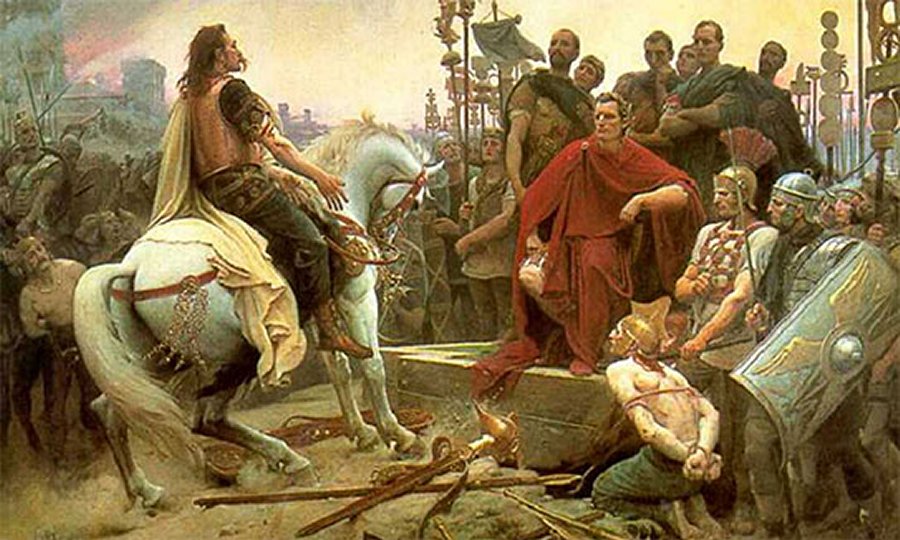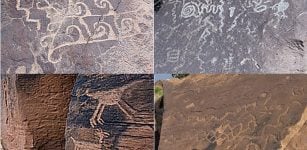Siege Of Alesia: Last Decisive Battle That Ended Gallic Independence In France And Belgium
A. Sutherland – MessageToEagle.com – The Battle of Alesia took place in September 52 BC. It was the culmination of Caesar’s successful campaigns to bring Gaul (modern France) into the Roman Empire.
For many years, Caesar had marched his soldiers across the country humiliating and slaughtering all Celtic tribes that resisted Roman rule. It took time but he finally ended Gallic independence in France and Belgium.

Despite the victory at Gergovia, the Arverni king, Vercingetorix, was reluctant to fight in the open field against the Roman forces and still led guerrilla raids and used scorched-earth tactics.
He knew his enemy, who was engaged in the Gallic Wars (58-50 BC); he knew that Caesar conquered the Gallic peoples one by one and these successes brought him political prestige in Rome and great wealth through the spoils of wars and the sale of war captives as slaves.

Now, Caesar had to confront Gallic rebellions, which threatened his control over Gaul. The next his success came when Vercingetorix’ forces attacked him north-west of Dijon, in eastern Gaul; the Gallic attack was resisted by Roman legions supported by the Germanic cavalry.
The confidence of the rebels was shaken and Vercingetorix withdrew to Alesia, and closed its fortifications. Caesar used to pass up such an opportunity, stopped the march south and chased the fleeing Gauls.

Commanding fewer than 50,000 legionnaires, Caesar began a siege. Caesar’s made his decision to continue the siege of Alesia and forcing the Gallic surrender by starvation. Approximately 80,000 men were stationed in Alesia, together with the local civilian population, so it was obvious that the city’s food supply could not last long.
Vercingetorix dispatched his cavalry to rally reinforcements from across Gaul, and in turn, the Romans decided to construct a double wall of fortifications around Alesia. The strengthening was facing towards and away from the city.
The walls stretched for approximately 25 miles, connecting with more than 50 miles of trenches, 23 forts, turrets, palisades and other obstacles disturbing the approaching Gallic warriors.
When Gallic support force arrived, the Romans had to face 80,000 men in Alesia and about 250,000 foot soldiers along with 8,000 cavalry attacking from outside the city.
After two days of heavy fighting, Caesar’s army was in trouble and on the third day, the Gauls captured the Roman camp, playing an important role in the Roman defense. To Caesar’s help came his German cavalry, which outflanked the Gallic forces and attacked them from behind and thus, the battle eventually turned to the Roman advantage.
The great Gallic leader, Vercingetorix, decided to surrender the next day. The three-day battle of Alesia was over; the Romans had won a decisive victory, destroying the powerful and very brave Gallic tribes.
The nation of Gaul was turned into a province of the Roman Empire. About one million Gauls had been sold as slaves and an equal number had been massacred; the remaining five million people had no choice – they accepted Roman rule.
After his surrender, Vercingetorix the Gaul, was taken to Rome where he was kept prisoner until he was executed in Julius Caesar’s triumph of 46 B.C.
Written by – A. Sutherland – MessageToEagle.com Senior Staff Writer
Copyright © MessageToeagle.com All rights reserved. This material may not be published, broadcast, rewritten or redistributed in whole or part without the express written permission of MessageToeagle.com
Expand for referencesReferences:
S. Sandler, Ground Warfare
M. L. Lanning, Battle 100: The Stories Behind History’s Most Influential Battles
Related Posts
-
 Astronomically Aligned Pyramidal Buildings Of America’s Oldest City Reveal How Its Builders Apprehended Space And Time
No Comments | Apr 15, 2021
Astronomically Aligned Pyramidal Buildings Of America’s Oldest City Reveal How Its Builders Apprehended Space And Time
No Comments | Apr 15, 2021 -
 Ancient Inscriptions Of Babylonian King Nabonidus Discovered In Saudi Arabia
No Comments | Jul 14, 2021
Ancient Inscriptions Of Babylonian King Nabonidus Discovered In Saudi Arabia
No Comments | Jul 14, 2021 -
 Simple 1,000-Year-Old Medieval Medicine Cure Can Treat Modern Infections – Study Shows
No Comments | Jul 28, 2020
Simple 1,000-Year-Old Medieval Medicine Cure Can Treat Modern Infections – Study Shows
No Comments | Jul 28, 2020 -
 7,000-Year-Old Kilns From Ceramics Workshop Unearthed In Northeast Bulgaria
No Comments | Nov 20, 2020
7,000-Year-Old Kilns From Ceramics Workshop Unearthed In Northeast Bulgaria
No Comments | Nov 20, 2020 -
 Statue Of Goddess Cybele Looted In The 1960s Returned To Turkey
No Comments | Dec 22, 2020
Statue Of Goddess Cybele Looted In The 1960s Returned To Turkey
No Comments | Dec 22, 2020 -
 Mysterious Tecaxic-Calixtlahuaca Head: Evidence For Ancient Trans-Oceanic Contact?
No Comments | Feb 10, 2015
Mysterious Tecaxic-Calixtlahuaca Head: Evidence For Ancient Trans-Oceanic Contact?
No Comments | Feb 10, 2015 -
 Lyman Lake Petroglyphs Left By Ancestors Of The Hopi Indians
No Comments | May 18, 2016
Lyman Lake Petroglyphs Left By Ancestors Of The Hopi Indians
No Comments | May 18, 2016 -
 El Mirador: Ancient Pyramids Hidden In The Lost City Of The Maya
No Comments | Jun 5, 2016
El Mirador: Ancient Pyramids Hidden In The Lost City Of The Maya
No Comments | Jun 5, 2016 -
 Dwarf Ninja Ukifune Jinnai’s Toilet Assassination Of Uesugi Kenshin
No Comments | Dec 16, 2019
Dwarf Ninja Ukifune Jinnai’s Toilet Assassination Of Uesugi Kenshin
No Comments | Dec 16, 2019 -
 Spectacular Statue Of Sea God Triton Found In Roman Mausoleum In Kent
No Comments | Sep 15, 2023
Spectacular Statue Of Sea God Triton Found In Roman Mausoleum In Kent
No Comments | Sep 15, 2023

